Acronis Disk Director: split disks without problems
Surely, you are familiar with a situation when you need to repartition partitions on a disk, but you really do not want to do this. Many are afraid to contact similar operations in the middle of the work week and put it off for the weekend, subconsciously knowing that you can’t keep up with this at 15 minutes. There is no need to list all the associated risks that have to be insured in such a case.
Meanwhile, there is an excellent program that allows you to quickly change a disk or system partition without wasting time backing up and restoring data. We are talking about Acronis Disk Director - a program that gives you the full control necessary for the efficient use of disks, allows you to combine, split, scale, copy, move individual partitions and much more.

Under the cut, we will consider the most popular features of the product and its interesting features.
The main application window contains all the information necessary for management. In the center there is a table of partitions and free space on disks, a graphic panel that allows you to find out the status of a disk, as well as the type, size, assigned letter, partition scheme and other information about all disks and volumes. Status helps to generally assess their condition.
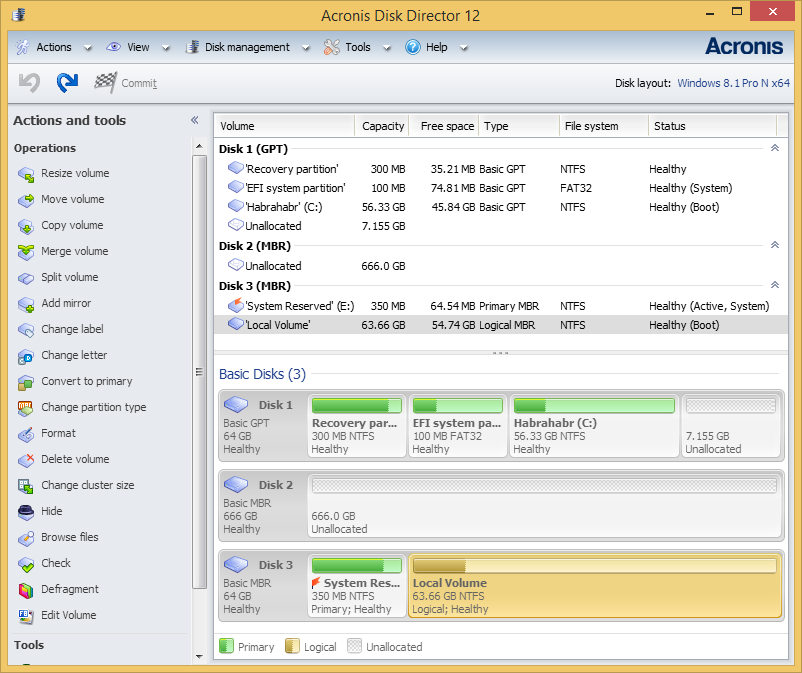
The panel on the left shows the operations that are possible for a particular object (in addition to the panel, they are also available in the context menu). In this case, one of the system volumes is selected in the screenshot.
The most popular feature of Disk Director is the ability to resize the volume and its position on the disk. It is very easy to do. It is enough to drag it with the mouse to the desired position in the volume resizing window:
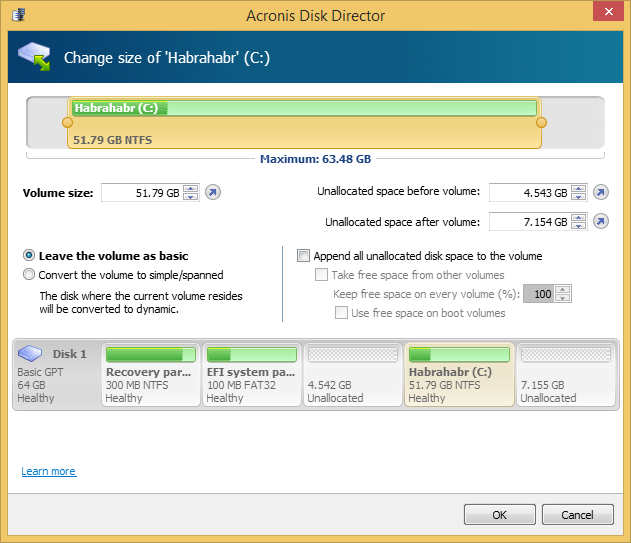
Or set the exact position and size in the input fields just below. If you resize the volume on a dynamic disk, you will be prompted to use all possible space in the group. Disk Director will independently calculate how to most efficiently use the free space depending on the type of volume (mirrored or striped).
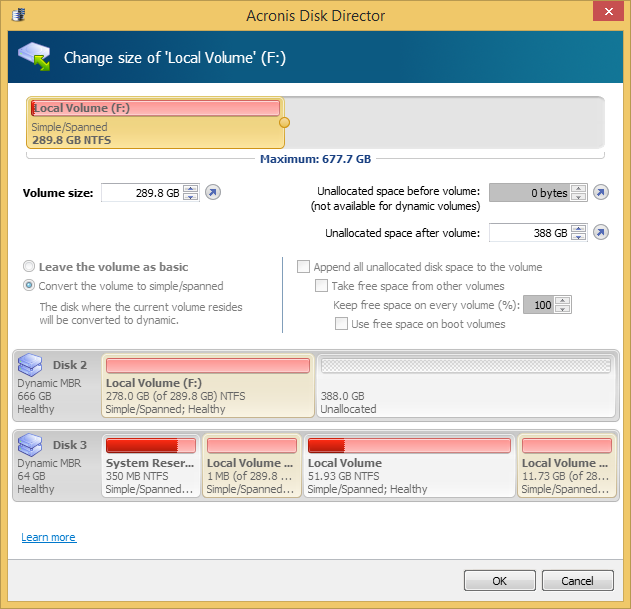
An equally popular option is the ability to split one volume into two, using the available free space. When splitting, you can also transfer part of files and folders from one volume to another.

The boundary between volumes can be set in two ways: by defining it in the input fields or by dragging the round separator with the mouse. Files are selected in a separate window after pressing the 'Select' button. This operation takes some time to calculate the size of the selected files in order to correctly display the possible border of the volumes.
With Disk Director, you can combine two adjacent base volumes, even if their file systems are different. All data is stored in the final volume, and the resulting volume to which the data will be added will have the same label, letter and file system as the original.

Convenient property of Disk Director: all operations on disks or partitions are not applied immediately. The program first suggests that you evaluate the result and only then make a decision. Undo / Redo is at your disposal, so the operation can be rolled back at any time.
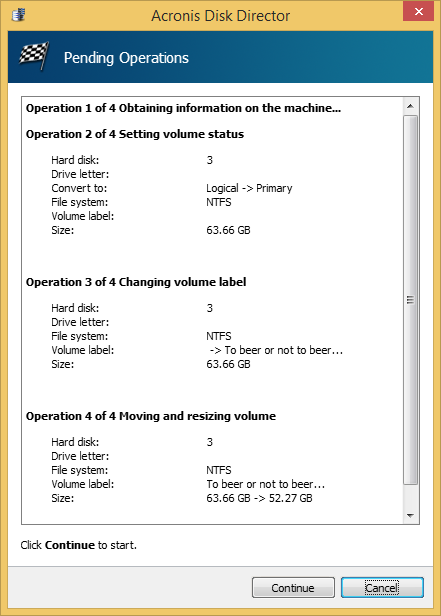
If your machine has several operating systems, there is no need to reboot and install Disk Director in each OS separately. This is especially true when changing the volume letter or when using dynamic disks. The name of the current OS is displayed on the toolbar; click on it to select another OS.
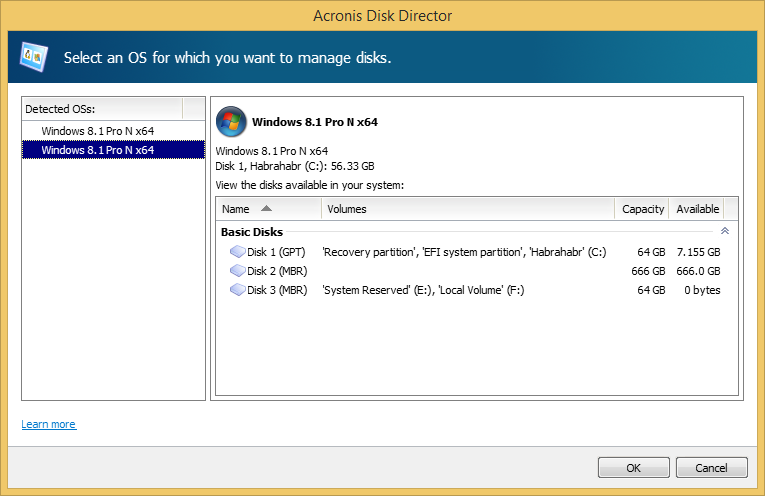
After you make a choice, information on disks and volumes will be displayed in such a way as if you had rebooted into the selected OS. You will see which letters have volumes in this particular system and you can change them or assign new ones. If you had an attached group of dynamic disks, you can work with it without resorting to import.
On bootable media, this window appears immediately after starting Disk Director. The disk structure will be displayed according to the selected OS.
Disk Director works on all versions of Microsoft Windows, starting with Windows XP, and ending with Windows 8, supports partition structures such as MBR, GPT and LDM (dynamic disks) as well as file systems FAT16, FAT32, NTFS, Ext2, Ext3, ReiserFS3 and Linux SWAP
More detailed information about the product can be obtained in the user manual , and in the comments we are ready to answer any of your questions.
Acronis Disk Director Project Manager
Grigory Zubankov
Meanwhile, there is an excellent program that allows you to quickly change a disk or system partition without wasting time backing up and restoring data. We are talking about Acronis Disk Director - a program that gives you the full control necessary for the efficient use of disks, allows you to combine, split, scale, copy, move individual partitions and much more.

Under the cut, we will consider the most popular features of the product and its interesting features.
Interface
The main application window contains all the information necessary for management. In the center there is a table of partitions and free space on disks, a graphic panel that allows you to find out the status of a disk, as well as the type, size, assigned letter, partition scheme and other information about all disks and volumes. Status helps to generally assess their condition.

The panel on the left shows the operations that are possible for a particular object (in addition to the panel, they are also available in the context menu). In this case, one of the system volumes is selected in the screenshot.
Resize a volume and its position on disk
The most popular feature of Disk Director is the ability to resize the volume and its position on the disk. It is very easy to do. It is enough to drag it with the mouse to the desired position in the volume resizing window:

Or set the exact position and size in the input fields just below. If you resize the volume on a dynamic disk, you will be prompted to use all possible space in the group. Disk Director will independently calculate how to most efficiently use the free space depending on the type of volume (mirrored or striped).

Volume Sharing
An equally popular option is the ability to split one volume into two, using the available free space. When splitting, you can also transfer part of files and folders from one volume to another.

The boundary between volumes can be set in two ways: by defining it in the input fields or by dragging the round separator with the mouse. Files are selected in a separate window after pressing the 'Select' button. This operation takes some time to calculate the size of the selected files in order to correctly display the possible border of the volumes.
Volume Merge
With Disk Director, you can combine two adjacent base volumes, even if their file systems are different. All data is stored in the final volume, and the resulting volume to which the data will be added will have the same label, letter and file system as the original.

Virtual operations
Convenient property of Disk Director: all operations on disks or partitions are not applied immediately. The program first suggests that you evaluate the result and only then make a decision. Undo / Redo is at your disposal, so the operation can be rolled back at any time.

OS selection
If your machine has several operating systems, there is no need to reboot and install Disk Director in each OS separately. This is especially true when changing the volume letter or when using dynamic disks. The name of the current OS is displayed on the toolbar; click on it to select another OS.

After you make a choice, information on disks and volumes will be displayed in such a way as if you had rebooted into the selected OS. You will see which letters have volumes in this particular system and you can change them or assign new ones. If you had an attached group of dynamic disks, you can work with it without resorting to import.
On bootable media, this window appears immediately after starting Disk Director. The disk structure will be displayed according to the selected OS.
Disk Director works on all versions of Microsoft Windows, starting with Windows XP, and ending with Windows 8, supports partition structures such as MBR, GPT and LDM (dynamic disks) as well as file systems FAT16, FAT32, NTFS, Ext2, Ext3, ReiserFS3 and Linux SWAP
More detailed information about the product can be obtained in the user manual , and in the comments we are ready to answer any of your questions.
Acronis Disk Director Project Manager
Grigory Zubankov
